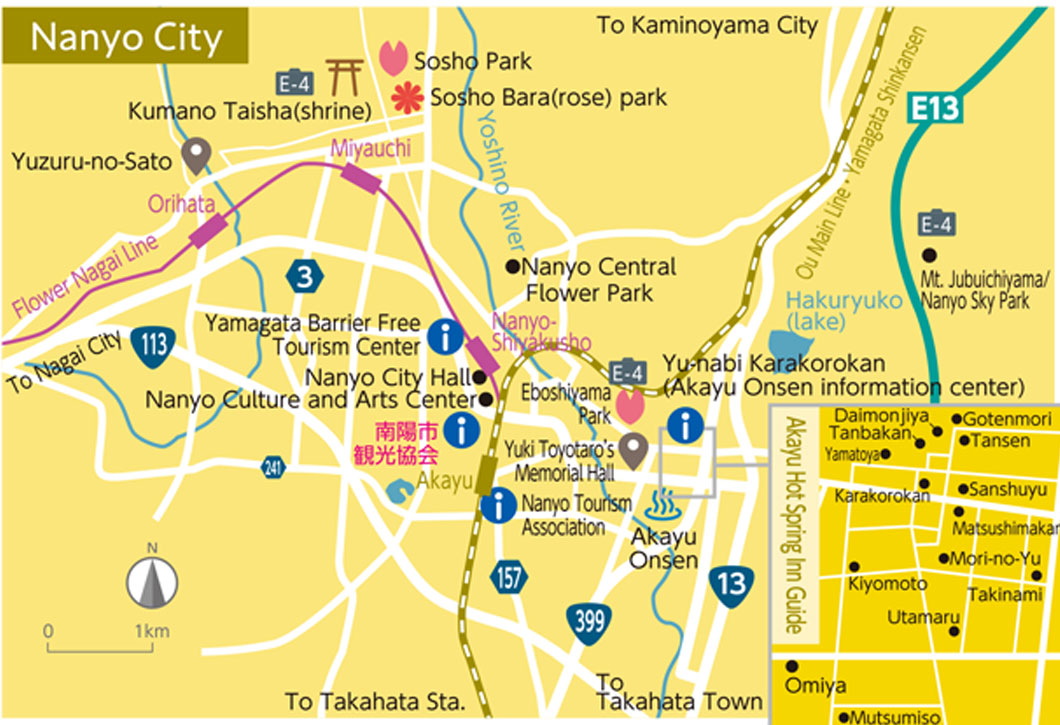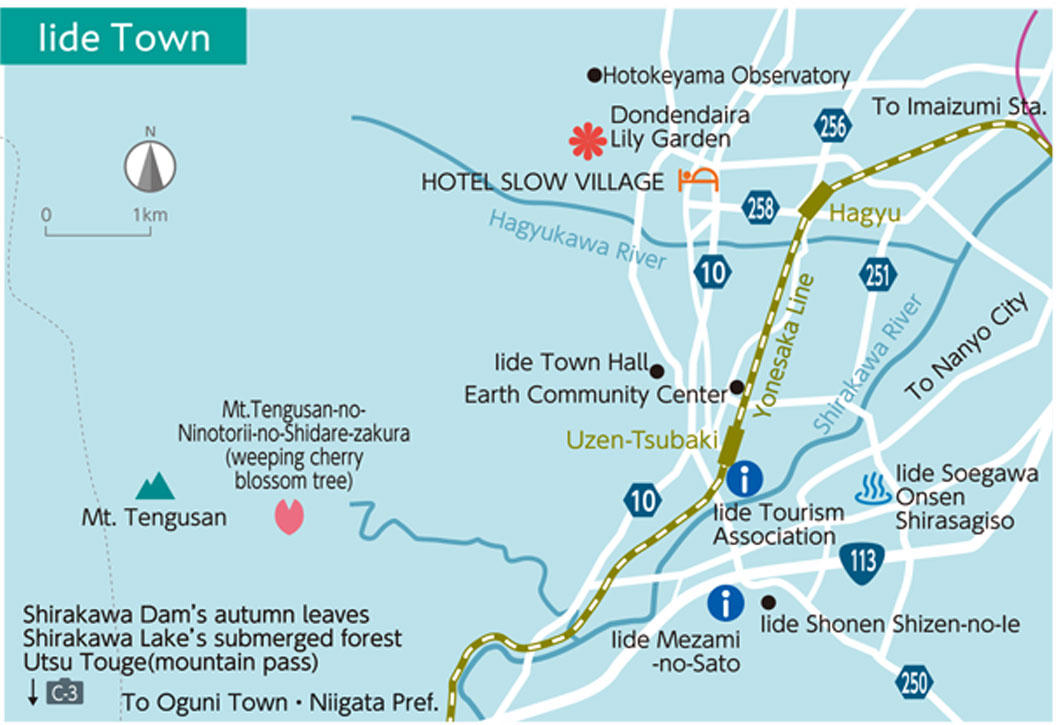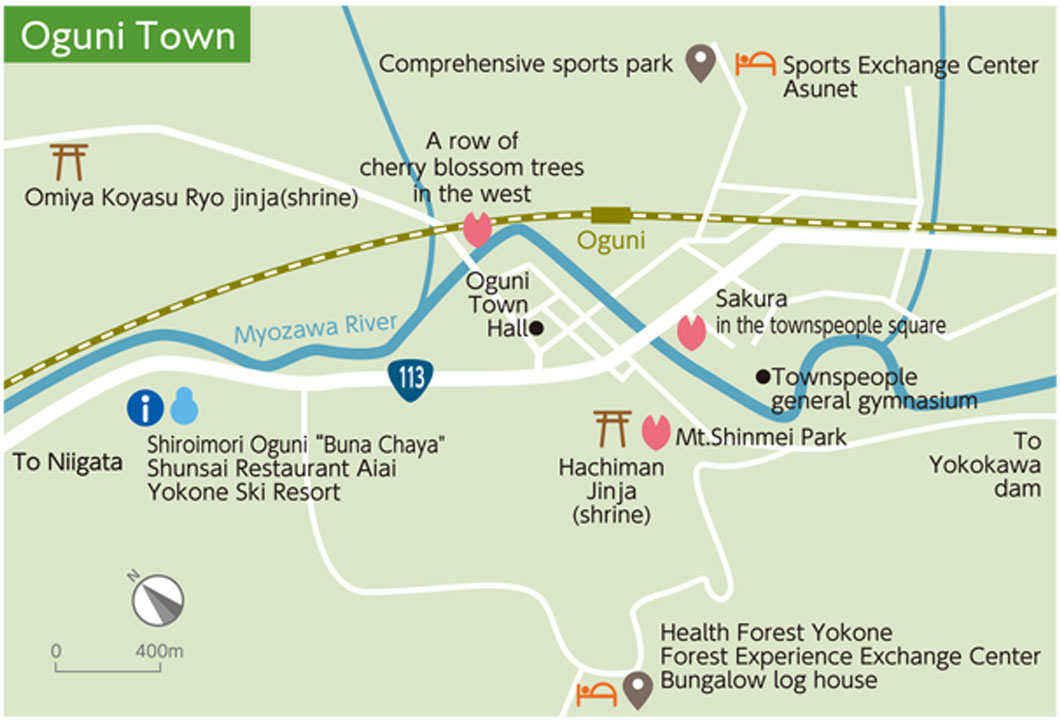The Arcadian Mountain Journey~To the Local Mountains, Where You Can Encounter a New Self~
The Arcadian Mountain Journey
~To the Local Mountains, Where You Can Encounter a New Self~
The Oriental Arcadia
(The Peach Blossom Spring)
Story
It was an extremely hot, but pleasant summer day.
Even the snow-capped peaks of Aizu,when shining in the sunlight,
did not appear cold.
The Yonezawa Plain. An Edenic paradise, with the thriving town of Yonezawa to the south,
and Akayu, a popular hot spring resort,attracting numerous visitors to the north.
A GARDEN OF EDEN.
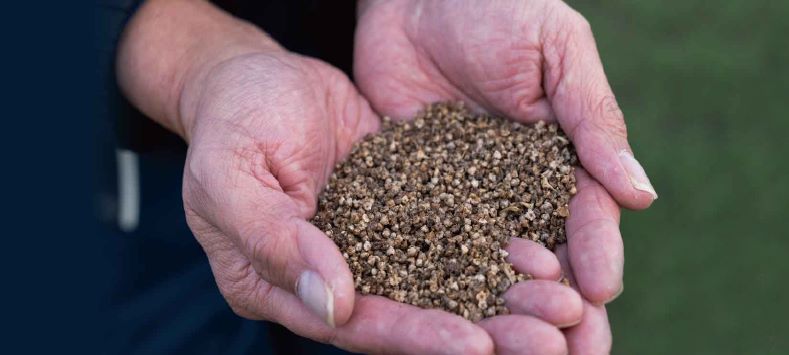
They cultivate an abundance of rice, cotton, corn, tobacco, hemp, indigo, soybeans,eggplants,walnuts,watermelons, cucumbers, persimmons, apricots, and pomegranates.
It is a vast land where smiles are abundant, an Asian Arcadia (The Peach Blossom Spring).
From Isabella Bird’s ‘Unbeaten Tracks in Japan’ (Translated by Kenkichi Takanashi), published by Heibonsha Library.
More than 150 years ago, in 1878,
the English female traveler Isabella Bird embarked on a journey from Tokyo to Hokkaido.
One of the purposes of her travels in Japan
was to witness the lives and cultures of the people in this newly blossoming civilization.
For much of her journey, she was guided by her interpreter, Ito.
Her experiences in Japan were compiled into a travelogue titled ‘Unbeaten Tracks in Japan.
In her extensive three-month journey,
Isabella Bird described the Okitama region as “a vast land where smiles are abundant, an Asian Arcadia (The Peach Blossom Spring).”
【The Related Article】Isabella Bird and the Arcadia of the East
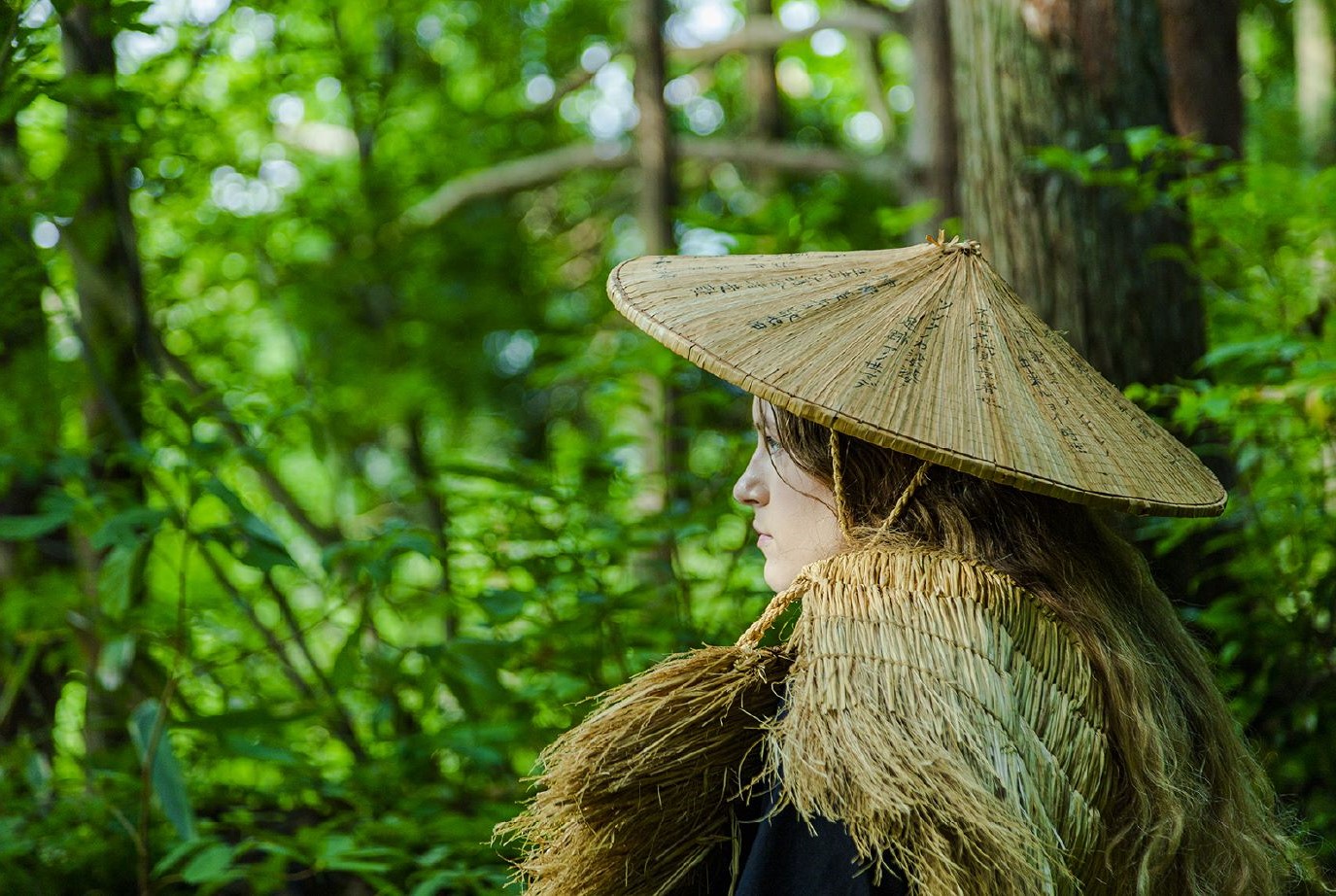
Tour
Arcadian Journey through Mountains is a traveler’s exploration, where the wanderer, much like Isabella Bird,embarks on a journey through the Oriental Arcadia, experiencing, feeling, and documenting the expedition in a travelogue akin to ‘Unbeaten Tracks in Japan.’
Ito, your guide to Arcadia, will lead you to a unique and special experience tailored just for you.
Exploring the lives of the locals,touching upon the culture that has thrived through generations, it becomes a moment to reflect on life and deepen one’s understanding of existence.
Monitor Tour

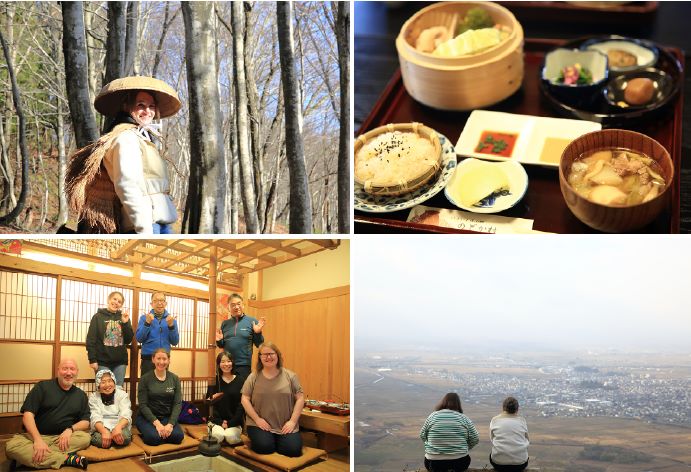
View Details
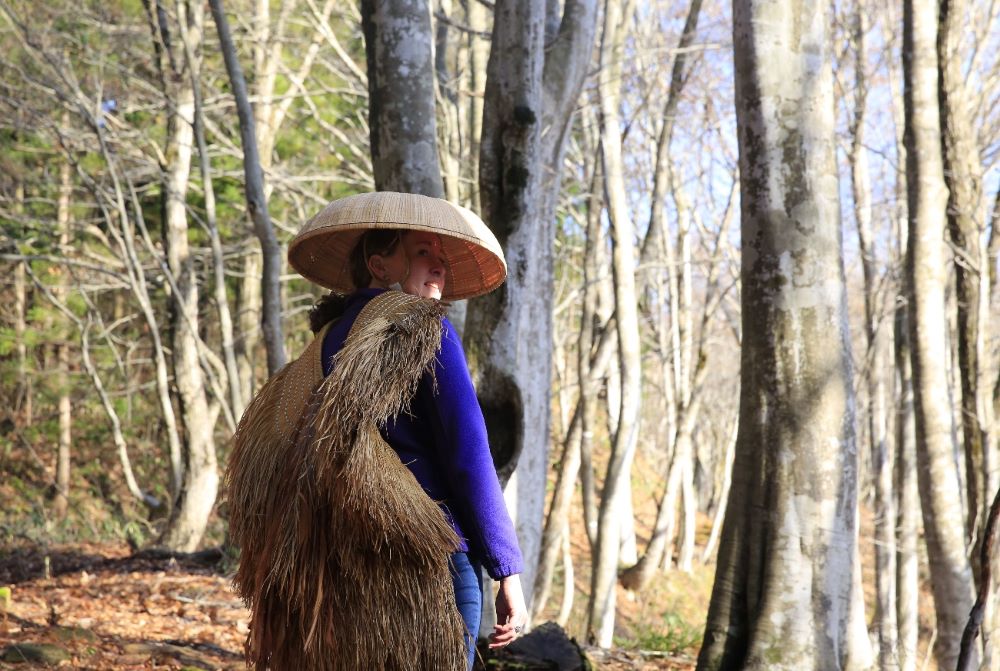
The entrance to Arcadia, the path traversed by Isabella Bird, known as the “Kurosawa Pass.”
Over 500 years ago, in the year 1512, a path was paved with 3,600 stones, cutting through the dense forest.
Just like Isabella Bird did in her time, people now walk wearing straw raincoats and conical hats made of rice straw.
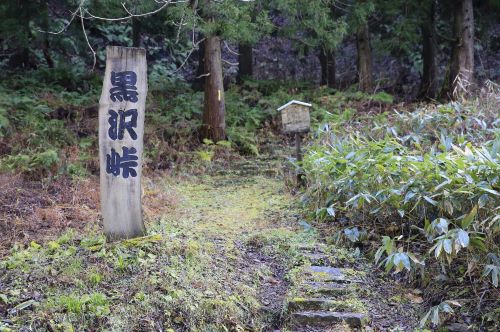
“Entrance to the Kurosawa Pass.” It has watched over the comings and goings of thousands of people. Even now, local residents continue to safeguard and pass down the mountain pass.
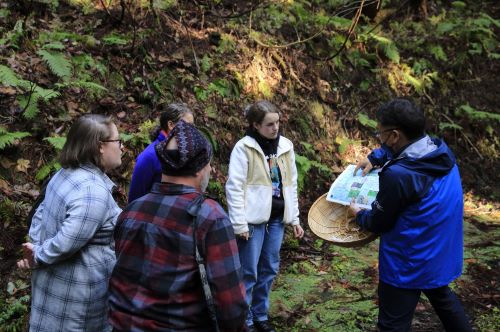
The guide, “Ito,” leads travelers to the Oriental Arcadia.
Minimal verbal explanations are given, as travelers are encouraged to experience the natural scents, sounds, and winds with their five senses and intuition.
Note: Ito was the first interpreter and guide in Japan who accompanied Isabella Bird from Yokohama to Hokkaido.

After a short drive from Kurosawa Pass, we arrive at the ‘Buddha Mountain Observatory,’
offering a panoramic view of the land Isabella Bird referred to as the Oriental Arcadia. Surrounded by mountains, the vast expanse unfolds with picturesque rural landscapes, providing a glimpse of the richness of people’s lives.
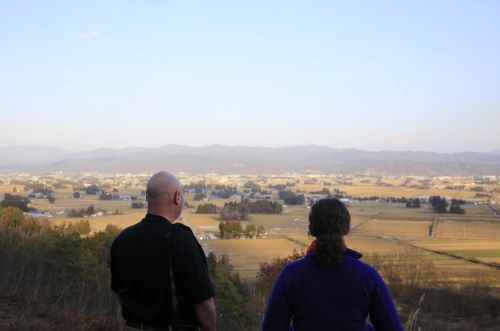
Travelers spend their time as they please,
imagining the landscapes and people’s lives during Isabella Bird’s travels, comparing them with their hometowns. Driving the anticipation for the upcoming stay in Arcadia.
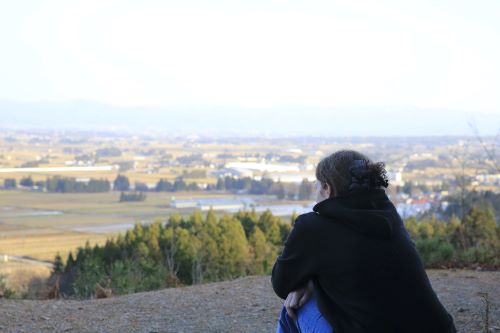
Reflecting on life.
In this place, there is time to let the heart peacefully wander through the journey of life.
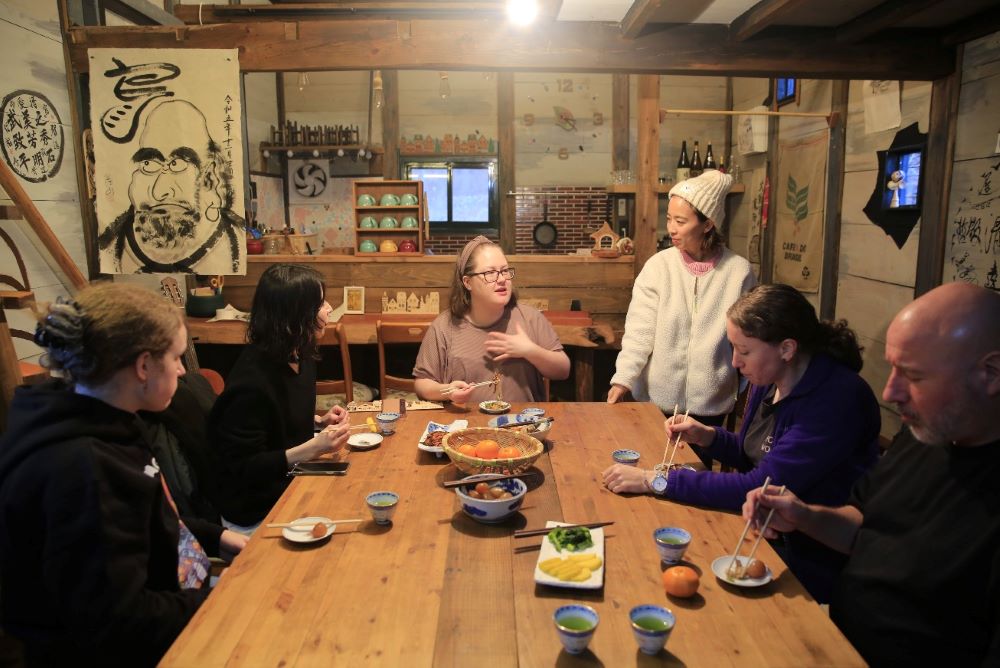
Interaction with the residents of Arcadia.
While enjoying tea, pickles, and mandarins, guests partake in a dish placed on the table, engaging in everyday conversations about where they come from, why they are on a journey, and the nature of their daily lives. Through such casual dialogues, mutual familiarity grows.
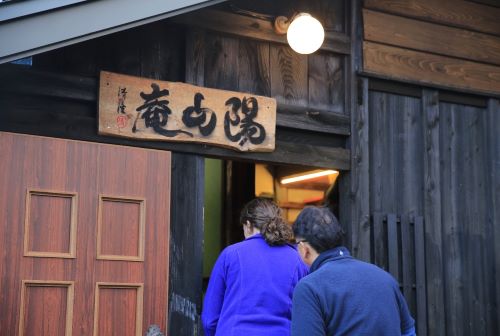
Visiting a local household is a surprise for the travelers.It’s challenging to enter a local’s home without a guide.

Inside the renovated warehouse, we get to see the homeowner’s hobby of calligraphy. Deepening our connection while experiencing a glimpse of a moment in Japanese life.

At one corner of the Arcadia area, in Nagai, we witness the dance of the Black Lion, which has continued for over 1000 years. We have the opportunity to see it up close during the annual event.
Nagai is a region prone to flooding due to the merging of water. The Black Lion symbolizes the flow of the river, pacifying the threat of water and expressing gratitude for the blessings of water as a water deity.

Under the serious gaze of the Black Lion, we enter the scene, receiving explanations about the patterns of its head and body along with the significance of its dance.
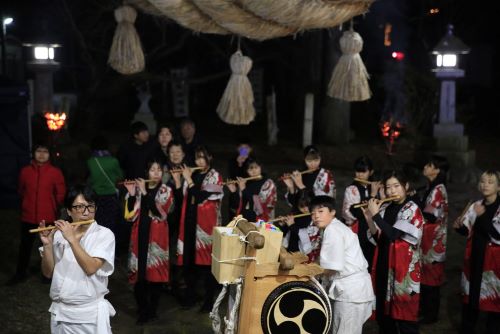
The precious tones of the transverse flute and drum resonate through the shrine grounds and the nearby homes. The pride of the local people is passed down from adults to children and on to the next generation.
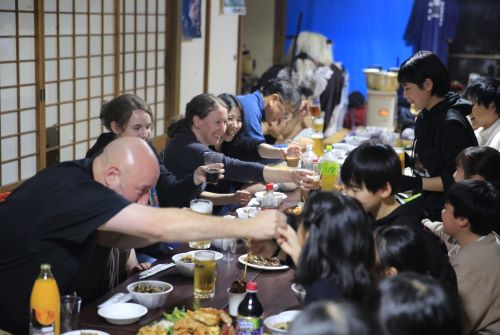
Participating in a direct meeting with the performers of the Black Lion dance. A direct meeting involves the participants of a religious ceremony consuming offerings and sake at the end of the ritual to purify themselves. The close interaction with the performers creates invaluable moments.
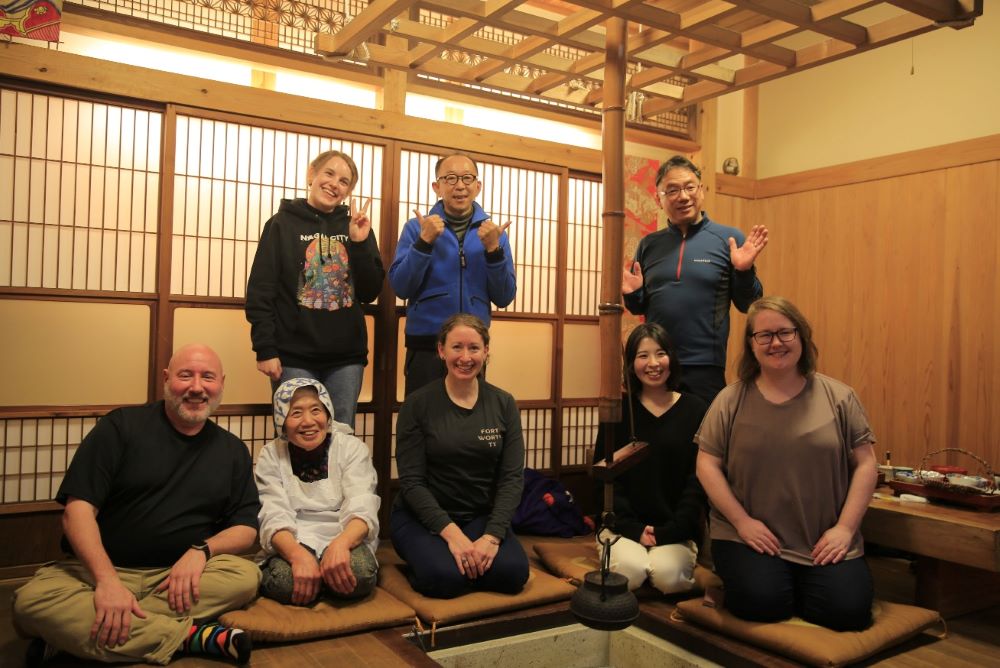
Nagomi-An offers locally sourced, pesticide-free vegetables and grains as the core of its regional cuisine. It was started by a full-time female farmer and her friend who shares a passion for agriculture. At the entrance, antique utensils used during the time of Isabella Bird’s travels are displayed, creating a dining space that evokes the bygone era of Japan.

Exchanging casual conversations while warming up by the hearth.
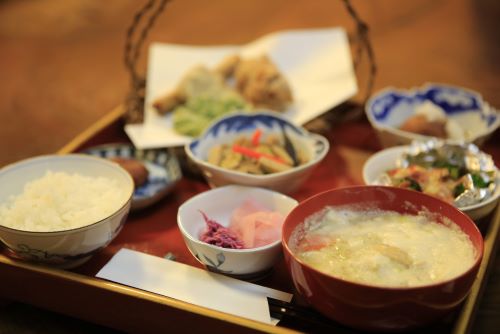
A variety of local dishes, including mountain vegetables, pickles, frozen fermented soybeans, deep-fried wheat gluten, and chilled soup, are lined up. These are traditional regional dishes that have been enjoyed in the area for generations. All the dishes are handmade, featuring a comforting and gentle flavor.
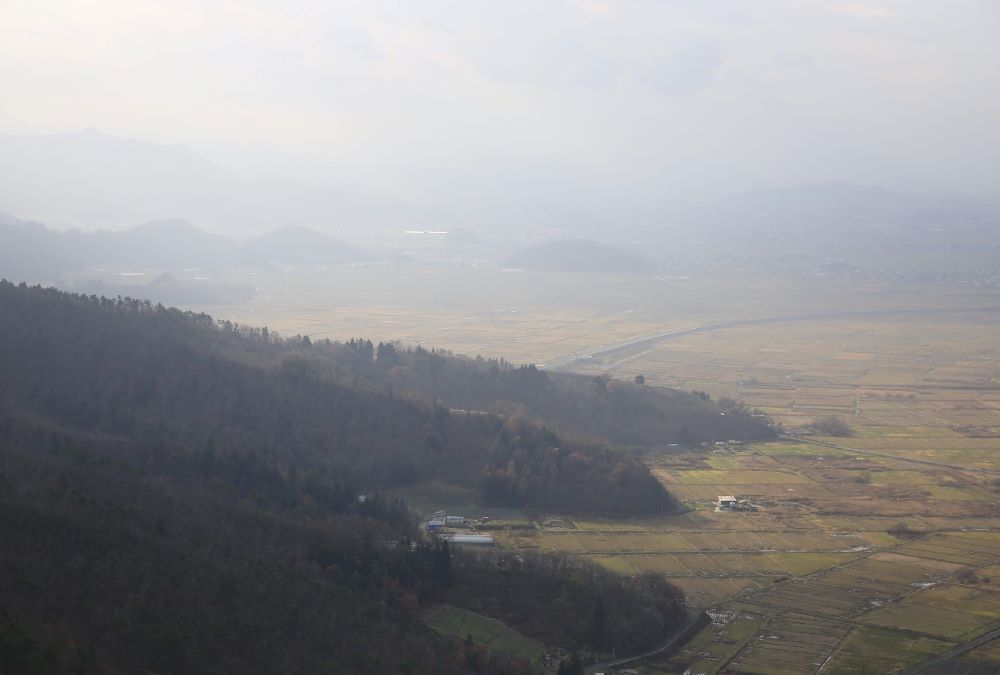
Gazing at Arcadia from Mt. Jubuiichi, which Isabella Bird described in her book ‘Unbeaten Tracks in Japan,’ stating, ‘The Yonezawa Plain is an Edenic paradise, with the thriving town of Yonezawa to the south, and Akayu, a popular hot spring resort attracting numerous visitors, to the north.
It is beautiful as if drawn with a pencil rather than cultivated with a hoe.

Trace the path you have traveled thus far while picturing the past and present. Imagine all the people who have passed through in the past 150 years.
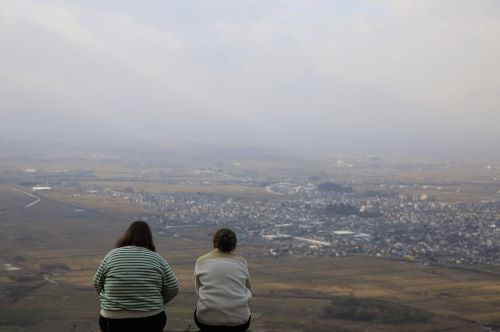
Isabella Bird spent time in the town, Akayu,that was right in front of her eyes, and then proceeded northward along the side of Mt. Jubuiichi.
As she looked down at the Arcadia she dubbed as the Garden of Eden from above, she shared her travel memories with fellow travelers.
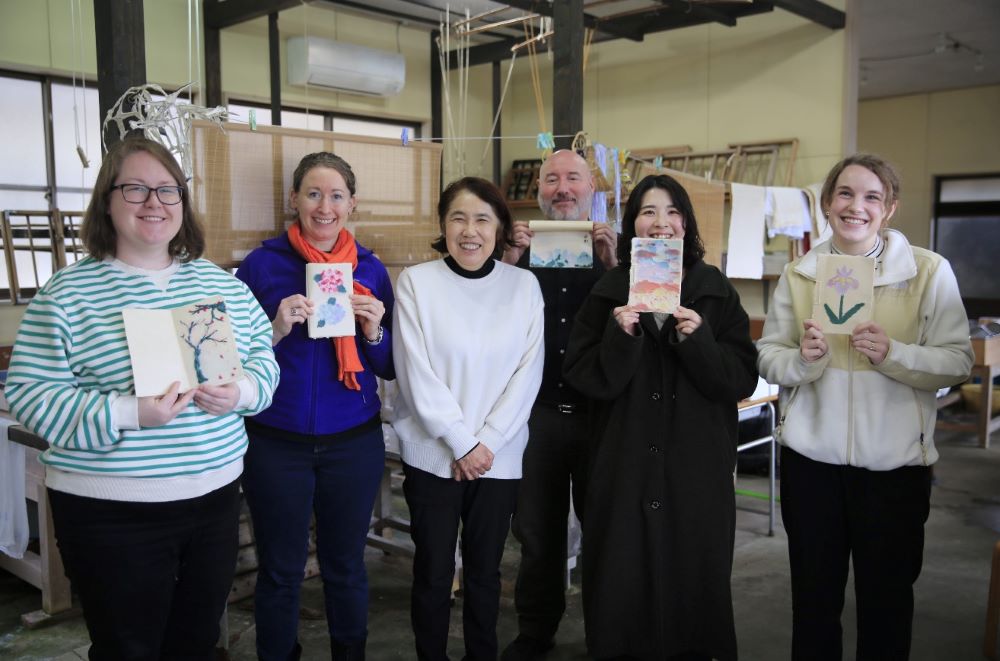
The travel journal handed over at the beginning of the journey is crafted from Miyama Washi, a traditional paper made in the Miyama region for over 400 years. At the ‘Miyama Washi Workshop,’ travelers express memorable scenes and favorite plants from their journey through torn-paper art, creating a unique and unparalleled travel record.

Colorful washi paper is cut into small pieces, glued together, and used to embellish the travel journal.
The front cover, back cover, and inner pages become canvases for personal expression. Washi paper, if kept in a good environment, can endure without deterioration for hundreds or even thousands of years. This allows the potential transmission of the feelings and experiences from the journey to future generations.

Creating torn-paper art, accompanied by skilled hands and fellow travelers, conversations flow. Engrossed in the process, words sometimes become sparse, and before you know it, an hour has passed.
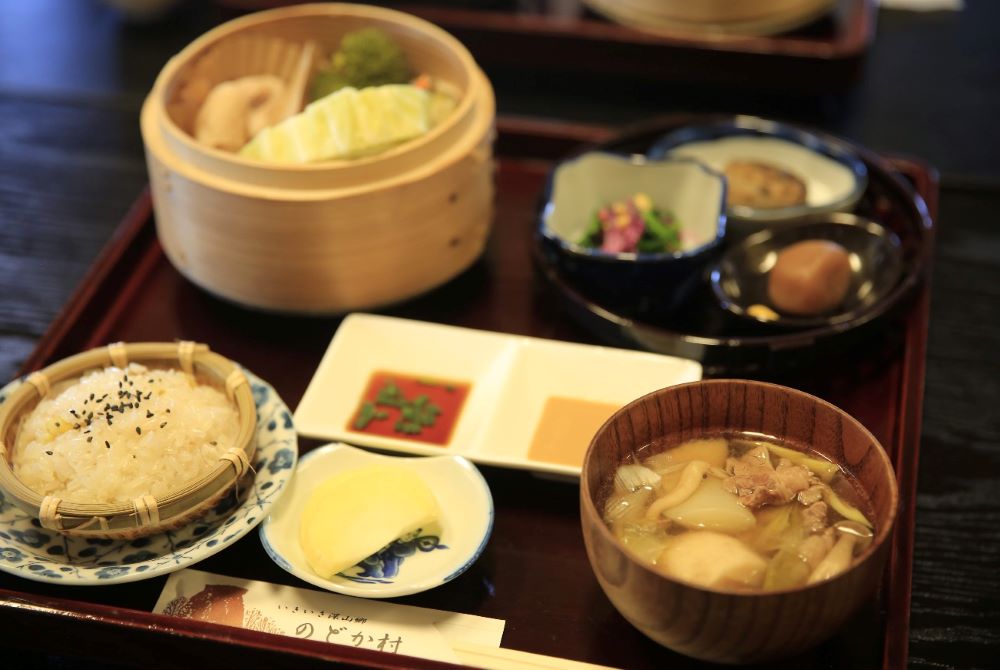
Next to the Miyama-Washi Workshop, lunch is enjoyed at ‘Nodoka Village,’ a traditional house. ‘Nodoka’ is a uniquely Japanese word expressing a quiet and peaceful atmosphere. Here, the flavors of the local mountains are savored.
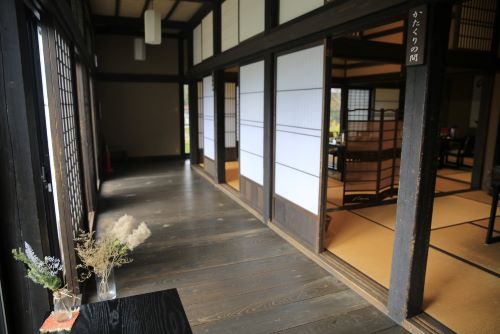
Nodoka Village is a reconstructed building that once belonged to a sericulture farmer, dating back more than 160 years. During Isabella Bird’s travels, the surrounding area of Shirataka Town was known for its thriving sericulture.
*Sericulture is the production of raw silk

Towards the end of the journey, camaraderie deepens among fellow travelers. They spend the remaining time sharing stories about their hometowns, professions, and the journey itself.
The course itinerary
| Tour Price | Per person,300,000 yen (including tax) (Please apply for 2 or more people.) |
|---|---|
| Travel Dates | A 2-night, 3-day period between May 15th and October 30th (Please specify your preferred dates when applying). However, excluding the period from August 10th to August 15th. |
| Travel Itinerary | Please see below |
| Reservation Deadline | 30 days prior to the date of the event. |
| Transportation | For 2 people: Private mid-sized taxi For 3 to 6 people: Private jumbo taxi. |
| Dress Code | Please wear comfortable clothing and shoes suitable for walking. In case of unfavorable ground conditions, we can provide rubber boots, so please inform us of your shoe size when applying. |
| Included in the Tour Price | Accommodation (2 nights), meal expenses (2 breakfasts, 3 lunches, 2 dinners), guide fees, travel journal, and rental items (straw raincoat, traditional hat, rubber boots, etc.). |
| Minimum Number of Participants | 2 people |
| Capacity | 6 people |
Tour Guide

Mr. Kuniaki Maruyama
Currently active in establishing a “town walking” volunteer organization with fellow enthusiasts. Takes pride in a profound love for the local community. With heartfelt dedication, aims to guide more people to experience the “Arcadia of the East” that Isabella Bird felt 150 years ago.

Mr. Toru Numazawa
A father of two children. During his previous employment with a travel company, he traveled across Japan and various countries worldwide. Currently residing in his hometown of Nagai City, he spends his days feeling the “Arcadia” while gazing at the scenery visible from his home.
<Regarding Application>
■About the Journey
You will experience the region in its natural state. The places we guide you through are not tourist attractions, but rather the daily lives of the people. If you are seeking typical tourist services, we kindly ask you to refrain from applying.
■About the Guide
The guide (Ito) plays a role in guiding you into the everyday life of the locals. Please be aware that their role goes beyond simple interpretation, as they facilitate a connection with the region, encouraging interactions with the people who reside there.
■Dietary Considerations
Please inform us of any allergies, vegetarian or vegan preferences, etc., at the time of application.
■Travel Day
As this tour involves interactions with local residents, the travel dates will be finalized after coordinating schedules. Therefore, when making inquiries, please specify your preferred travel dates. We appreciate if you could provide your preferred dates up to 30 days in advance.
To apply or inquire
Our Will
The Arcadian Mountain Journey is a rural mountainous travel experience created to fulfill the mission set by the Yamagata Arcadia Tourism Bureau since its establishment: ‘Bringing the Oriental Arcadia to Children.’ Each stop along the way is designed to contribute to the future of the local community. To ensure the continuity of these places for the generations to come, a portion of the tour fees will be allocated towards maintaining mountain passes, viewpoints, environmental enhancements in townscapes, and funding for local festivals.
| MISSION | [Bringing the Oriental Arcadia to Children] We, together with the residents, workers, and visitors of this land, strive to create a region that is high in both spiritual and economic well-being, for passing it on to the next generation. |
|---|---|
| VISION | [Japan’s Strongest Local] Yamagata, the welcoming land of abundant nature, sustainable communities, and a home to return to anytime. Surrounded by greenery and flowers, a beautiful rural landscape. With People bustling about, the town enveloped in the smiles of its residents, brimming with vitality. Those who live, work, and visit here reflect on this place known as the ‘Oriental Arcadia.’ Taking pride in calling this place home, we aspire to be the ‘Japan’s Strongest Local’ that will continue for a hundred years and beyond. |
| BRAND CONCEPT |
Yamagata Arcadia ~The Local Mountains, Where You Encounter a New Self~ |


